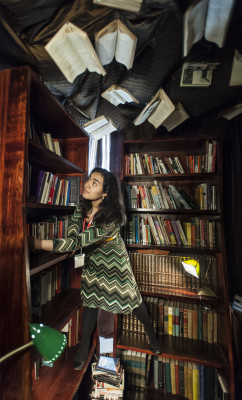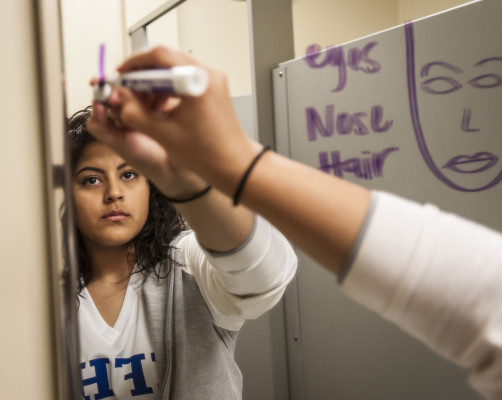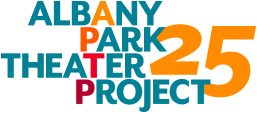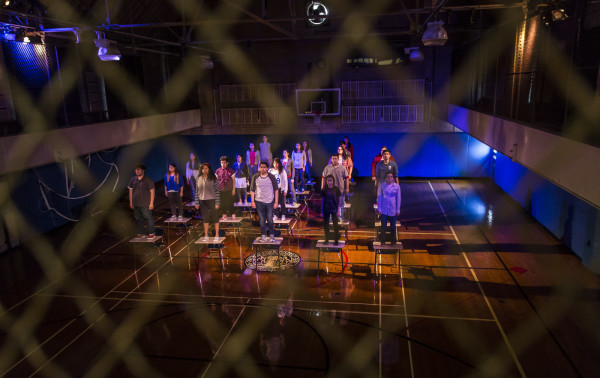Chicago Reader//Aimee Levitt: In a lot of ways, Ellen Gates Starr High School in Logan Square isn’t much different from other CPS neighborhood schools. Enrollment and funding are down, and the school is on probation: the results of standardized tests from this year, currently in session, will determine whether it stays open.
Teachers know they’re in danger of layoffs, and that the news will probably arrive in an e-mail in the middle of a school day. Students worry about what they’ll do after graduation; the ROTC office, where they can play video games, drink pop, and chill with the recruiter, looks much more inviting than the cramped and closet-size guidance department.
But daily life goes on. Ms. Torres’s English students are reading The Great Gatsby and have pushed their desks into a circle for a discussion called “The American Dream: Fiction or Possibility.” Kids sneak whiskey and kiss in the stairwells and have revelatory conversations in the bathroom. The clock still moves too slowly when they’re sick of sitting in class and too fast when they’re trying to finish a math test.
The only difference between Starr High and other schools—and, yes, it’s a pretty big one—is that Starr High doesn’t really exist. The building, formerly Saint Hyacinth Basilica School, a parochial school that closed in 2015, has been converted by the Albany Park Theater Project into the set of Learning Curve, its newest production, opening this weekend.
Like other APTP shows, Learning Curve is a collaboration between teenagers in the Albany Park neighborhood and adult directors who construct plays around social issues, based on interviews with people in their community. Past shows have explored immigration, the financial crisis, and food, subjects that are part of the students’ daily lives. Given that APTP is a youth theater company, education seemed like a natural fit. But at first, cofounder and artistic director David Feiner was reluctant.
The only difference between Starr High and other schools—and, yes, it's a pretty big one—is that Starr High doesn't really exist.

“We wanted to make sure we had something significant and transformative to add to the conversation,” he says. “Then we thought, What if the audience comes into a school building for a show and the first thing they see is a metal detector?”
That is exactly what happens when the audience walks into Learning Curve. The conceit is that the audience, limited to 40 people at a time, will spend a school day at Starr High, from first bell to the last—or an abbreviated two-hour school day anyway. They’ll wander the halls, they’ll go to class, they’ll talk with teachers and students, all played by members of the APTP ensemble. Not every audience member will see every scene. Some, like Ms. Torres’s English class’s discussion of The Great Gatsby and the American dream, are central to the piece, but other bits in stairwells or in bathrooms need to be discovered. Some scenes are intended for a full classroom, while others will be strictly one-on-one.
“The great thing about the way one-on-one works,” Feiner says, “is that, when it’s ideal, you feel like it’s an exchange. You’ve made a connection with a person. You’re part of a strange and beautiful experience.”
Just don’t call it interactive theater.
“We’re crafting an experience for the audience,” Feiner explains. “This is at the core of what we do: We give the audience an experience and take them on a journey and bring them into a world. The audience members need to understand that they have a place in this world and that they’re significant in the world of the show. The world would not continue if they were to walk out.”

Creating a believable world is the first and most important goal of any theatrical production. But the immersive quality of Learning Curve provides an additional challenge. The actors can’t just learn their lines. They also have to learn to talk with audience members in a natural way and guide the conversation along to its intended conclusion and then guide the audience to the next destination without breaking character. Canned responses destroy the illusion that audience members are participating in something real—they might as well be interacting with robots.
In order to help the young actors learn this kind of theater, APTP partnered with Third Rail Projects, a company from Brooklyn that specializes in immersive, site-specific performances. Jennine Willett, cofounder of Third Rail, has made five trips to Chicago since September to lead workshops and help APTP’s 31 actors and eight directors build the various scenes in Learning Curve. She compares each scene to a wire frame. “It can be vastly different from one person to the next,” she says. “We work with where people are. Some audience members want to be part of it, others want to hold back. You need to be present and nonjudgmental and open. But knowing the marker points allows you, the actor, to think on your feet. The performers know all the pathways a scene can take.”
For the past several months, Maria Velazquez has been working with Willett on a dance-centered piece about a teacher who has been laid off. Velazquez based some of the scene on interviews she and other APTP performers had done with teachers at Roosevelt High School in Albany Park.
The element of surprise makes it more fun for the performers too. “When we were working on a scene and we never knew what would happen, the work was fun,” says Maria Velazquez, who also helped create the show. “When you say the same thing, the answers always lead to the same thing.”
So if you wander into the JROTC office, Abraham “Kito” Espino, who plays the recruiter, will greet you warmly, offer you a drink from his minifridge, and invite you to play a round of darts. Then he’ll settle in behind his desk, a sign that he’s about to get down to business, and signal that you should take the other chair. He’ll ask you questions about your interests, your future plans, your family. Do you like to travel? How many push-ups can you do? Even if you admit you can’t do any push-ups at all, he’s undaunted: “Do you like challenges? I knew as soon as I saw you you were one of my people!”
In other scenes, the audience takes a more traditional spectator role while the APTP performers create a different, more heightened sort of reality through dance or percussion or musical elements. For the past several months, Velazquez has been working with Willett on a dance-centered piece about a teacher who has been laid off. Velazquez based some of the scene on interviews she and other APTP performers had done with teachers at Roosevelt High School in Albany Park.
“We started with the movement,” Velazquez says. “There was no context, no why or what. We just knew the teacher had been laid off, and her movements would be slow and dragging.”
Eventually they decided they would show the exact moment when the teacher learns she’s been laid off, from a colleague outside the classroom door, and that she won’t even be allowed to finish the day. This is a particularly enthusiastic and engaged teacher: she teaches social studies or history, and she’s decorated her walls with posters highlighting the achievements of women and African-Americans, people most history books ignore. The audience becomes a classroom of her students, sitting at their desks, watching her devastation.
“Imagine you’re in ninth grade and you’ve just bonded with this adult,” Feiner says. “It’s hard work. And then that adult is taken from you.”

If Learning Curve is to have any sort of emotional impact on its audience—and naturally, its creators hope it will—a lot of it will come from tapping into audience members’ own memories of high school. (No one younger than 14, high school age, will be allowed in.) Or, as Feiner puts it, “You can be yourself and be present as a student in this world, and you experience this moment and you experience your teachers of the past. We want to make you feel like your favorite teacher—mine was Meg Smith—might walk up to you again, or you can be with her urban 2016 counterpart.”
“There’s something about a tactile, multisensory experience that evokes memories,” Willett adds.
The Starr High building itself evokes memories, not all of them as pleasant as time with your favorite teacher. The halls are painted the same drab beige you probably remember from your own school, and the classrooms are filled with the same uncomfortable little desks. It has the same dusty school smell. (For added verisimilitude, the school shows up on Google Maps. Feiner discovered that if enough users vet a place, Google can be convinced that it exists.) There’s a reason many people don’t have fond memories of high school. It feels a little bit like jail. But, like the scenes, the set design has its moments of surreality as well. Inside the labyrinth of bookshelves (filled with donated books) that makes up the library, a few volumes hang suspended from the ceiling, flapping like birds or some of the more magical books at Hogwarts. Even in a troubled CPS school, it seems to say, marvelous things can happen.
And that is the magic of theater, at least theater the way APTP does it.Learning Curve is not about a story, it’s about a building and the people in it, including the audience.
“One of the things we do well,” Feiner says, “is creating a performance where the audience is aware that something is happening that is real. It’s not the verisimilitude of fiction. It’s real, and it’s happening right now.”
Chicago Reader//Aimee Levitt
 Menu
Menu
